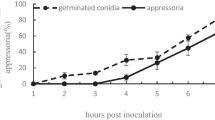Summary
The presence of mycoplasma has been demonstrated in the phloem of leaves of white clover (Trifolium repens L.) affected by clover dwarf. Mycoplasma-like bodies were found both in parenchyma and companion cells and in sieve elements.
In young parenchyma and companion cells mycoplasma-like bodies appeared as round or oval particles with high ribosomal content, delimited by a ribosome-bearing membrane. Their diameter ranged between 50 and 400 nm. In mature sieve elements they were larger, more pleomorphic, and showed a central clear area containing presumed DNA filaments. Budding and dividing forms were sometimes seen among them.
The main alterations found in the infected cells were: increased ribosome content, dilation of the perinuclear space, degeneration of mitochondria and chloroplasts, and cytoplasmic vacuolation. Many cells appeared completely disrupted and their content was replaced by a great number of pleomorphic mycoplasma.
Similar content being viewed by others
References
Anderson, D. R., andM. F. Barile, 1966: Ultrastructure ofMycoplasma orale isolated from patients with leukemia. J. nat. Cancer Inst.36, 161–169.
—, andR. A. Manaker, 1966: Electron microscopic studies of Mycoplasma (PPLO strain 880) in artificial medium and in tissue culture. J. nat. Cancer Inst.36, 139–154.
Belli, G., 1969: Mycoplasma-like particles in clarified extracts of diseased rice plants. Riv. Pat. Veg. S. IV5, 85–93.
Clowes, F. A. L., andB. E. Juniper, 1968: Plant cells. Oxford and Edinburgh: Blackwell Scientific Publications.
Giannotti, J., A. Caudwell, C. Vago etJ. L. Duthoit, 1969 a: Isolement et purification de micro-organismes de type mycoplasme à partir de vignes atteintes de Flavescence dorée. C. R. Acad. Sci. (Paris), SérieD 268, 845–847.
—,G. Devauchelle, G. Marchoux etC. Vago, 1969 b: Recherches sur le pléomorphisme des micro-organismes de type mycoplasme chez les plantes atteintes de jaunisses. C. R. Acad. Sci. (Paris), SérieD 268, 1354–1356.
—,G. Marchou, C. Vago etJ. L. Duthoit, 1968: Micro-organismes de type mycoplasme dans les cellules libériennes deSolanum lycopersicum L. atteinte de stolbur. C. R. Acad. Sci. (Paris), SérieD 267, 454–456.
Hirumi, H., andK. Maramorosch, 1969: Mycoplasma-like bodies in the salivary glands of insect vectors carrying the Aster Yellow agent. J. Virol.3, 82–84.
Luft, J. H., 1961: Improvement in epoxy resin embedding methods. J. biophys. biochem. Cytol.9, 409–414.
Maillet, P. L., J. P. Gourret etC. Hamon, 1968: Sur la présence de particules de type Mycoplasme dans le liber de plantes atteintes de maladies du type « jaunisse » (Aster Yellow, Phyllodie du Trèfle, Stolbur de la Tomate) et sur la parenté ultrastructurale de ces particules avec celles trouvées chez divers Insectes Homoptères. C. R. Acad. Sci. (Paris), SérieD 266, 2309–2311.
Maramorosch, K., E. Shikata, andR. R. Granados, 1968: Structures resembling mycoplasma in diseased plants and insect vectors. Trans. N.Y. Acad. Sci., Series II,30, 841–855.
Pellegrini, S., and F. M.Gerola, 1970: Mycoplasma-like bodies in phloem cells ofOryza sativa. Electron microscopy observations. J. Microscopie (in press).
Ploaie, P., andK. Maramorosch, 1969: Electron microscopic demonstration of particles resembling Mycoplasma or psittacosis-lymphogranuloma-trachoma group in plants infected with European Yellows-type diseases. Phytopathol.59, 536–544.
Reynolds, E. S., 1963: The use of lead citrate at high pH as an electron-opaque stain in electron microscopy. J. Cell Biol.17, 208–213.
Author information
Authors and Affiliations
Additional information
This investigation was supported by a grant of Consiglio Nazionale delle Ricerche, Rome.
Rights and permissions
About this article
Cite this article
Lombardo, G., Bassi, M. & Gerola, F.M. Mycoplasma development and cell alterations in white clover affected by clover dwarf an electron microscopy study. Protoplasma 70, 61–71 (1970). https://doi.org/10.1007/BF01276842
Received:
Revised:
Issue Date:
DOI: https://doi.org/10.1007/BF01276842




